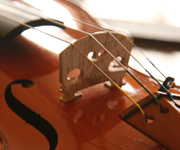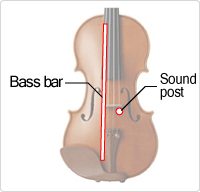The Structure of the Violin
How sound is produced
The vibration of the strings produces a spectacular sound
Vibrations from the strings are transmitted to the top plate and bottom plate through the bridge, and this reverberates within the hollow body, producing the rich, brilliant tone characteristic of the violin.
A bowed string vibrates and moves in a circular motion that produces the fundamental tone, while the vibration produces overtones like a rippling wave. This complex movement of the string is transmitted to the body by the bridge. The bridge transmits this vibration to the top plate of the violin through two fundamental movements; one in which it pushes down on the top plate alternately one foot at a time, and the other in which both feet push down on the top plate simultaneously.

The bridge transmits the vibrations of the strings
There is another small yet important part: the sound post. The sound post is a post sandwiched between the top plate and the bottom plate underneath the bridge, and it transmits the vibrations from the top plate to the bottom plate. It also serves to preserve the shape of the body.
If you look inside a violin, you can see the bass bar running up the left hand side as you face the instrument. The piece sitting under the bridge on the right-hand side is the sound post.

The position of the bass bar and the sound post
Musical Instrument Guide : Violin Contents
Origins
Structure
How to Play
How the Instrument is Made
Choosing an Instrument
Care and Maintenance
Trivia
- The f-hole used to be a C-hole or S-hole
- Why the f-hole?
- Violinists must bow to the horse
- Steel strings or gut strings? That is the question
- Is the chinrest the unsung hero of the violin?
- Most violin varnishes are also medicines
- Violin masterpieces: Solos I
- Violin masterpieces: Solos II
- Violin masterpieces: Solos III
- Violin masterpieces: Concertos I
- Violin masterpieces: Concertos II
- Viola masterpieces: Chamber music
- Viola masterpieces: Concertos
- Cello masterpieces: Concertos I
- Cello masterpieces: Concertos II
- Cello masterpieces: Solos
- Contrabass masterpieces: Concertos
- Contrabass masterpieces: Chamber music
- Orchestral masterpieces featuring the contrabass
- What do you call the part on the bow that you hold?
